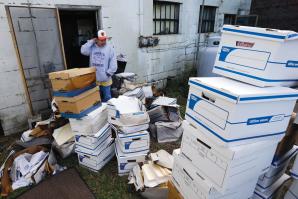Most business owners manage by instinct, but there are those times when they need a robust spurring.
“We didn’t have a solid disaster plan until about a year ago,” says Mark Rodebaugh, managing partner with Reznick Group PC in Sacramento. “Then our clients started asking us about it out of concern for their financial information and tax filings.”
As a public accounting firm with clients and offices across the country, Reznick couldn’t afford to endure a catastrophic loss wherein all its clients’ data vanished. Over several months, the company developed a full-fledged business continuity plan, designed to help it recover and regain operation within two to four hours of a worst-case scenario. Now if a disaster occurs, recovery should be so seamless that clients might not even notice.
Taking those steps put Reznick Group into a much better category of statistics. Research from Gartner, an information technology research and advisory company, says three out of five businesses that experience a disaster never recover and ultimately shut their doors permanently. Many are either underinsured and can’t cover the costs, or, more often, have their ability to meet clients’ needs compromised, forcing customers to go elsewhere.
Any business owner who’d like to start having anxiety attacks should spend 15 minutes talking to a disaster expert about what could go wrong.
Fires and floods are certainly the most obvious and destructive. As for catastrophic floods, no city in the country is more at risk than Sacramento, and flooding isn’t limited to rivers overtopping levees. Pipes can burst over a weekend, if not in your building, maybe the one next door. Storm sewers can back up. There is no such thing as high and dry.
Beyond the elements, however, a disaster is best described as anything that causes your operation to sit idle. Experts refer to this idle time between disaster and operational recovery as the “flatline,” and it can be caused by more things than most of us want to think about.
There’s been much press in recent months about pandemics, for example, but not from a business perspective.
“With something like H1N1, it only takes one case of an employee getting sick and suddenly your whole business has to shut down,” says Rob Carpenter, president of Servpro of Citrus Heights, Roseville and Carmichael. “We’ve all seen schools shut down over one case. It’s no different in a workplace environment. Even if the doors stay open, business owners need to plan for an event that could result in a substantial number of their employees being sick and unable to work.”
Another worst-case scenario could be “sick building syndrome,” which is often the result of longstanding mold in a building’s infrastructure. The workplace could be sealed off for weeks while it’s cleaned and disinfected.
Flatline time can even be caused by disasters that strike other businesses. If your business is a tenant in a shopping center where the anchor suddenly goes belly up, what will that mean for your operation? Worse, what if a critical supplier suddenly goes down?
“I was called in at one point when a noodle factory went down right before the Chinese New Year,” says Leo Grover, president of Pinnacle Emergency Management. “That was certainly bad for my client, but also for every single customer he supplied.”
The thought of a terror attack brings indelible images to mind. While disasters on that scale are less likely, the possibility that a workplace could become a crime scene cannot be overlooked. Many still remember when the Unabomber struck Sacramento in the early 1990s.
Even a fairly benign situation could require the workplace to stay closed while an investigation proceeds. There’s also the chance of a cyber attack or outright theft of your computers, proprietary information, business plans and other critical property.
“I was called in at one point when a noodle factory went downâ?¨ right before the Chinese New Year.”
Leo Grover, president, Pinnacle Emergency Management
Succession plans are also important, though few companies anticipate what they will do if there’s a sudden loss of organizational decision makers. As if that’s not terrifying enough, there is also the prospect of secondary damage that could come from failing to respond to the disaster fast enough.
“The way you handle a disaster from its very onset will determine how soon you’re back up and operable,” Grover says. “You have to jump on it. That means communicating to your employees, customers and suppliers, and taking whatever steps are necessary to ensure the physical damage isn’t made worse by inaction.”
A good example of secondary damage could be a post-fire or flood situation in which everything is left wet for too long and mold becomes a problem. Secondary damage could also involve the company reputation if there’s a perception the response isn’t being handled or liability concerns if contract obligations can’t be met.
Every baseball coach at some point tells his players to ask themselves, “What am I going to do if the ball comes to me?” The answer requires taking stock of the situation and determining the best action. Preparing for a disaster involves the same philosophy. Ask yourself what kind of losses would flatline your business. Know what the critical business functions are for your company and how they could be affected in the event of a catastrophe.
“You have to ask yourself what your vulnerabilities are in terms of … the risks that could directly affect the bottom line,” Grover says. “A grocery store needs its freezers and cash registers to work, for example, otherwise they’re out of business. So every grocery store you walk into today has backup generators in case of a power loss.”
The best way to make sure the right questions are being asked is to perform a risk assessment to identify those vulnerabilities and their likely impacts. From there, it becomes a step-by-step process of mitigating vulnerabilities. Automated daily computer backups might be one example, as well as a relocation plan that can have employees at a functional workspace within 24 hours. Many CPA firms offer data backup and disaster recovery services, as well as good advice on how to work with the Internal Revenue Service in the event of a disaster.
“The nightmare scenario is one where a business loses all the data it needs to report to the tax authorities,” says Greg Burke, a CPA with John Waddell & Co. in Sacramento. They’re faced with trying to reconstruct it from third parties or telling the IRS they don’t have it. Neither is a very pleasant experience.”
On the plus side, however, Burke says a business can deduct some or all (depending on insurance) of the value of damaged assets as well as the expenses necessary to recover or repair losses.
Finally, communications functions are vital. Everyone in the company should know their roles and the plan for implementation. Clear responsibility should especially be given for who, and who alone, is going to speak for the company with customers, other employees and the media.
“The nightmare scenario is one where a business loses all the data it needs to report to the tax authorities.”
Greg Burke, CPA, John Waddell & Co.
Disasters affect four main components: people, operations, facilities and assets, and technology. A business continuity plan not only provides the roadmap for helping a business recover from a disaster, but it is also a clear plan for managing the crisis as it occurs. Developed properly, it can provide a single recovery strategy that can be used across all types of incidents.
“Plan for the worst, and you’ll be ready for everything that could happen” Carpenter says. “Just don’t try to wing it. Usually it’s not the disaster that shuts a business down forever; it’s the lack of a plan.”
While larger businesses may have the option to appoint a disaster recovery manager or team, the good news for businesses of any size is that they need not go it alone. There are several professional firms to help businesses assess and mitigate risk and prepare a continuity plan.
The cost of working with a professional, which may be somewhere in the low-to-mid five-figure range, depending on the business, is a bargain in Rodebaugh’s opinion
“The best advice I’d give other business owners is to follow their better instincts and get a plan done,” he says. “By using a professional, as we did, you can benefit from their knowledge of best practices. The cost is nothing compared to the cost of losing your business altogether.”
A professional firm can also help test the plan once it’s developed and upgrade the plan as your business changes over time. The maxim in the industry is a business continuity plan is never really done. In general it’s advised to review the plan every year or as the business undergoes significant changes, such as a move.
If a full-blown plan isn’t an option, there are still a few immediate steps to at least reduce potential impacts. First, scan originals of key documents. The originals can be stored in a secure location, such as a safe deposit box or fireproof safe. Second, regular and secure backup of computer data is essential. If you’ve also scanned key documents, a backup system provides a critical redundancy in the event the originals and electronic data are somehow lost at once.
“You should also review your insurance coverage, and be sure it’s adequate.” Burke says. “Replacement costs change, so insurance coverage should be reviewed regularly to make sure proceeds will be adequate to cover a loss.”
Protecting Personal Assets
Disasters that strike your business could also strike your home. With many small-business owners, personal and commercial finances overlap and must be protected. The following are steps you can take to protect assets, minimizing financial loss and expediting recovery:
Protect your property. Think about ways you can avoid or reduce property damage if a disaster were to strike. Know where to turn off water, gas and electric lines. Install smoke detectors. Clear surrounding brush to protect against wildfires, use wind-resistant shingles on your roof and secure objects that could fall and cause damage. If you’re not sure where to start, contact your local fire department for recommendations.
Conduct a household inventory. Make a list of your possessions, and estimate their value for insurance or tax purposes. Include model and serial numbers. If possible, take photos or video of your possessions. Save receipts for valuable items, and get professional appraisals of jewelry, collectibles and artwork. These expensive items need to be listed individually in your insurance policy. Store this list in a safe deposit box at a bank.
Have adequate insurance. If necessary, seek special or additional coverage for floods, earthquakes or other losses not covered by standard insurance. If you own a home, you should purchase — at a minimum — full replacement or replacement cost coverage. This means the structure can be replaced up to the limits specified in the policy. Even better protection, although not always available, is guaranteed replacement cost coverage. This means the policy will pay to rebuild your house at today’s prices, regardless of the limits of the policy. Check to see if the policy covers changes in the building code, and look for a policy that covers the replacement cost of your possessions, not just the cash value. Finally, don’t overlook the importance of wind and hail, health, disability, long-term care, umbrella liability, life insurance and flood insurance.
Keep cash available. Stash a small amount of cash at home in a place where you can access the funds quickly in case of evacuation or if a disaster shuts down local ATMs and banks. Set aside extra money in an emergency bank account, and keep your credit cards paid off so you will have enough credit to get you through a disaster.
Use an evacuation box and safe deposit box. Put important papers in a box that you can grab in the event of an emergency. Include cash, negatives of important personal photographs, a list of emergency contacts, copies of prescriptions and medical records, copies of insurance policies, backup disks of critical computerized information, copies of other important family and financial records, and your safe deposit box key. Store original documents, property deeds and birth certificates in a bank safe deposit box.
Make an evacuation plan. Imagine that you could take only one suitcase or pack a single carload in the event of a disaster. What would you take, how would you leave your home, where would you rejoin your family and who would you call if you became separated?
Do additional research. The California Society of CPAs has created a free website of articles, tools and resources to help consumers. These can be found at calcpa.org.
Recommended For You

All Wet
Would your vital documents be safe in the face of disaster?
On the Staten Island waterfront, long-time beloved Italian eatery Puglia by the Sea rises from the waves with floor to ceiling windows offering dramatic ocean views. White tablecloths sit foreground to a grand cherry-and-brass bar, and patrons regale over stately plated mussels, antipasto and filet mignon. Or, they did. Until Hurricane Sandy.

Cumulous Data
The opportunities and hazards of cloud computing
While most businesses are postponing investments and stashing cash, at least one expense is expected to grow this year: information technology.



